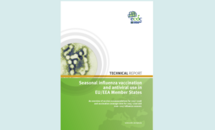Seasonal influenza vaccination and antiviral use in EU/EEA Member States
A survey was circulated in January 2018 to provide an update on seasonal influenza immunisation policies in 2017– 18 and obtain vaccination coverage rates in EU/EEA Member States for the 2015–16, 2016–17 and 2017-18 (if available) influenza seasons. In addition, the survey mapped methods of monitoring vaccination coverage, vaccine dose number procured, payment mechanisms for vaccine and vaccine administration, vaccine products recommended by population groups and complementary antiviral use for treatment or prophylaxis in vaccinated and unvaccinated individuals.
Download

Read more on this site
Influenza vaccination coverage rates insufficient across EU Member States
None of the European Union (EU) Member States could demonstrate that they reach the EU target of 75% influenza vaccination coverage for vulnerable groups, according to a new report from the European Centre for Disease Prevention and Control (ECDC).
Influenza vaccination coverage rates in the EU/EEAArchived
ECDC is collecting, sharing and disseminating information on national vaccination programmes and provides guidance for improving the overall performance of the vaccination systems in EU/EEA Member States. The latest data on vaccination coverage by country in the EU/EEA of different risk- and target groups are available in the reports listed on this page.
Factsheet about seasonal influenza
General disease information for public health experts and the general public on seasonal influenza.
More about this topic
Seasonal influenza vaccines
Guidelines, information and data on vaccination for seasonal influenza.
Seasonal influenza vaccination strategies
There are several possible immunisation strategies for seasonal influenza.
Risk groups for severe influenza
Some people are at high risk of serious complications as a result of influenza, some of which can be life-threatening and result in death.
Types of seasonal influenza vaccine
Injected trivalent inactivated influenza vaccines are most commonly used throughout the world. Influenza antigen preparation varies between manufacturers.
Immunity following influenza disease and administration of influenza vaccines
Information on natural immunity and immunity after vaccination, and the evaluation of immune response after vaccination in the EU.
Timing of influenza vaccination
It takes 10 to 14 days following vaccination, before an immune response and protection develops. Therefore, most countries start immunisation in the early autumn.







